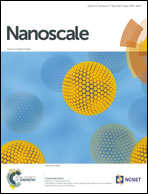Tunable multiferroic and bistable/complementary resistive switching properties of dilutely Li-doped BiFeO3 nanoparticles: an effect of aliovalent substitution†
Abstract
We report a potential way to enhance and tune the multiferroic and resistive switching properties of BiFeO3 nanoparticles through dilute aliovalent Li1+ doping (0.046 atomic percent) at the Fe3+ sites of BiFeO3. The high purity of the samples and the extent of doping were confirmed by different physical characterizations. Enhanced multiferroic properties with a magnetic moment per Fe atom ≈ 0.12 μB and electric polarization ≈ 49 μC cm−2 were observed in one of the Li1+ doped samples. A phenomenological model has been proposed to support the observed magnetic behavior of the doped samples. From a potential application point of view, we further report on the doping concentration and polarization coercivity dependent highly stable resistive switching behavior (endurance cycles >103 and stability >106 s) of Li-doped BiFeO3 nanoparticles. The stable complementary resistive switching behavior (1 bit operation) for >50 cycles and under voltage pulse for 103 cycles in the doped BiFeO3 at a low operating bias is reported. Thus, dilute aliovalent Li1+ doping enables tunability of the ferroic and resistive switching properties of BiFeO3and shows it to be a promising multiferroic material.


 Please wait while we load your content...
Please wait while we load your content...